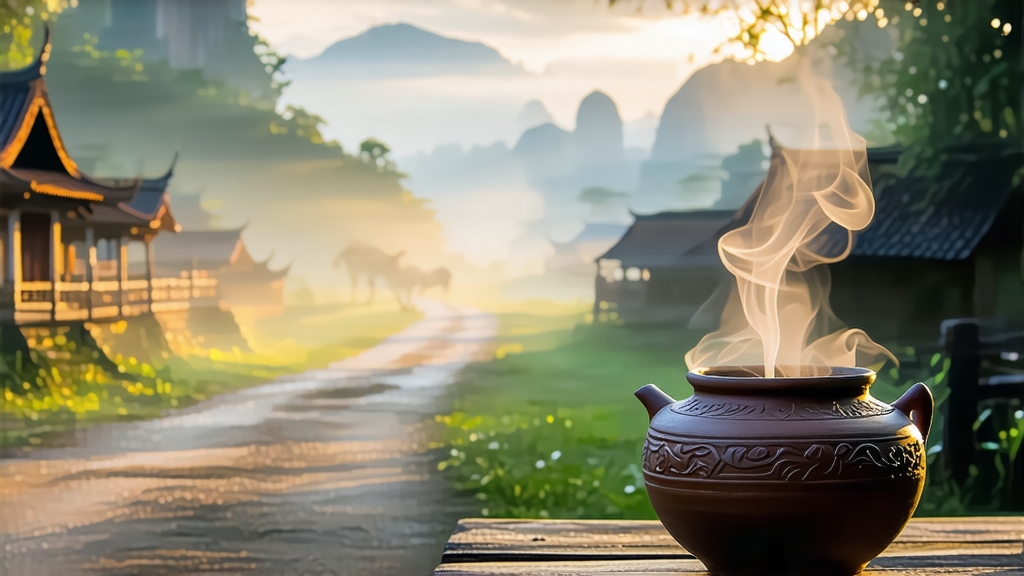
Tucked away in the humid mountains of southern Guangxi, Liu Bao tea has spent four centuries quietly fermenting while its more famous cousins—Pu-erh and Anhua Dark—dominated the global conversation about Chinese dark tea. Yet for traders who once walked the Tea Horse Road, Liu Bao was liquid currency, prized for the way it settled stomachs after greasy yak-butter meals and for the depth of flavor that seemed to improve with every mile it traveled. Today the tea is experiencing a renaissance among specialty drinkers who crave the earthy comfort of post-fermented leaves without the price tag of vintage Pu-erh. To understand Liu Bao is to listen to a story told by microbes, bamboo smoke, and the slow heartbeat of cargo boats that once plied the Xun River.
Historical records first mention “Liu Bao” in the late Ming dynasty, when Wuzhou city served as the gateway between the tea-producing mountains of Cangwu county and the Pearl River delta. Local gazetteers from 1630 describe “black cakes from Liu Bao village” being loaded onto junks bound for Guangzhou and, eventually, Hong Kong and Southeast Asia. British port ledgers of the 1880s list the tea as “Lieu Pau—medicinal quality,” noting that Malay tin miners consumed it to ward off malaria. The name itself simply means “six forts,” referring to the six defensive stockades built during the Song dynasty to protect tea warehouses from river pirates. Over time the geographic label became synonymous with the dark, mellow tea that matured inside those stone walls.
Although Liu Bao is a single protected geographical indication, the micro-region produces three distinct leaf styles that differ in pluck standard and finishing technique. Guan Cha, the oldest style, uses a two-leaf-and-a-bud standard harvested in early April; the leaves are deliberately bruised to encourage enzymatic oxidation before piling. San Cha, developed for export in the 1950s, relies on larger late-spring leaves and a shorter pile-fermentation to create a lighter cup favored by Hong Kong dim-sum restaurants. The rarest expression, Gong Cha, is made from tiny early-March buds that undergo an extra bamboo-basket charcoal roast, yielding a liqueur so smooth it was once reserved for jade merchants in Guangzhou. Each style shares the same microbial driver—Aspergillus niger and Blastobotrys adeninivorans strains native to the pine-wood storehouses of Wuzhou—but the varying leaf chemistry produces dramatically different flavor arcs over decades of aging.
The craft begins in the mist-cooled gardens that climb the granite slopes of Cangwu at 300–500 m elevation. Growers keep the bushes, predominantly a local large-leaf cultivar known as “Wu Ye,” at waist height so that morning fog can linger around the tender shoots. After picking, the leaves are withered on bamboo screens set above the kitchen stoves of village houses; the gentle heat infuses a faint wood-smoke note that later harmonizes with the deeper fermentation aromas. Once the leaves pass the “soft leather” test—pliable enough to bend without snapping—they are rolled in 5-kilogram batches inside linen sacks that are trodden by barefoot rollers in a slow dance that twists the cell walls without pulverizing them. The rolled leaves are then heaped into pine-sided troughs 60 cm deep, covered with wet jute sacks, and left to ferment for 18–24 hours. Temperature probes are inserted every 30 minutes; when the pile hits 58 °C the tea master “fluffs” the heap to aerate the microbes and prevent sourness. This phase, called “wet piling,” is Liu Bao’s equivalent of Pu-erh’s wo dui, yet the shorter duration and higher ambient humidity of Guangxi produce a sweeter, less musty baseline character.
Once the leaves have turned a uniform chestnut brown, they are sun-dried on raised bamboo racks for three consecutive days, absorbing the resinous scent of nearby pine forests. The semi-dried mao cha is then packed into 40-kilogram bamboo baskets lined with untreated rice paper and transferred to the famous “cool caves” beneath Wuzhou’s limestone hills. Here relative humidity hovers at 78 % and temperature stays a constant 22 °C year-round, allowing a slow secondary fermentation that can last anywhere from six months to thirty years. Every quarter the tea master climbs into the cave to rotate the baskets, ensuring even microbial exposure. Over time white “golden flowers”—Eurotium cristatum—bloom across